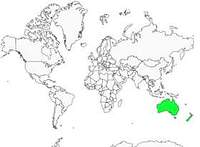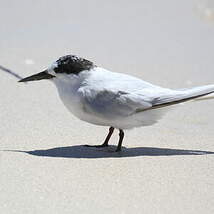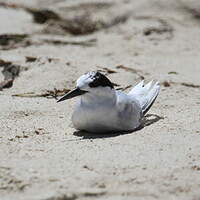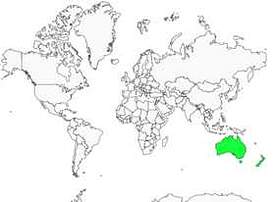Fairy Tern
Sternula nereis - Sterne néréis
Identification
The Fairy Tern (now in the genus Sternula) breeds in southern Australia, from Tasmania (nominate subspecies) to the Perth region (subspecies horni), New Caledonia (subspecies exsul) and Northern New Zealand (subspecies davisae). It is very similar to the Little Tern (Sternula albifrons) which also breeds on eastern shores of Australia and with which it occasionally hybridizes. It is distinguished by its uniformly pale gray back, upper and lower wings (darker in the Little Tern where the dark primary remiges contrast with the rest of the wing). The rump is white in both species. The Fairy Tern's beak is completely orange yellow (black tip in the Little Tern) and there is no thin white line above the eye. When perched, the Fairy Tern's wings protrude more clearly beyond the tail. Immatures of both species are very similar, the relative length of the wings and the tail being the best criteria for distinguishing them as well as the color of the beak, that of the Fairy Tern being paler at the base (uniformly black in the Little Tern).
Subspecific information 3 subspecies
- Sternula nereis nereis (w and s Australia)
- Sternula nereis exsul (New Caledonia)
- Sternula nereis davisae (n North I.. New Zealand.)
Foreign names
- Sterne néréis,
- Charrancito australiano,
- chilreta-australiana,
- Australseeschwalbe,
- déltengeri csér,
- Elfenstern,
- Sterna fatata,
- australisk småtärna,
- Alveterne,
- rybár čarovný,
- rybák australský,
- Alfeterne,
- australianpikkutiira,
- xatrac menut pàl·lid,
- rybitwa nadobna,
- Австралийская крачка,
- ヒメアジサシ,
- 眼斑燕鸥,
- australisk småtärna,
- 眼斑白額燕鷗,
Habitat
Behaviour character trait
Dietfeeding habits
Reproduction nesting
Breeding begins in early September in the northern part of its range, late September in the south, and no earlier than November in New Zealand. Australian birds nest in colonies, while New Zealand pairs are generally more spaced out. The nest is a depression dug into the sand or shell beds. The clutch is no more than 2 eggs. Incubation takes just over 3 weeks, and the young take flight 3 weeks later but remain dependent on their parents for another 2 months.
Threats - protection
IUCN conservation status
concern
in the Wild
threatened
evaluated
The Fairy Tern is classified as Vulnerable by BirdLife International. The population has strongly decreased and does not exceed more than 2,000 pairs (probably more than 10,000 at the beginning of the 20th century). Apart from disturbances, it suffers from competition from the Little Tern whose numbers are on the rise. The New Zealand subspecies is threatened with extinction, with its numbers down to only thirty individuals at the beginning of the 21st century. It only breeds in two sites north of Auckland, while it used to be widespread along the coastlines of the two main islands at the beginning of the 20th century. Disturbances due to tourist activity and predation by introduced mammals are the main causes of this decline, which could be irreversible even though intense protection has allowed the numbers to grow from 4 pairs in 1983 to a little more than a dozen by the end of the 1990s.
Sources of information
- IOC World Bird List (v15.1), Gill, F and D Donsker (Eds). 2025-12-07.
Other sources of interest
 Specification sheet created on
01/08/2023 by Georges Olioso
Specification sheet created on
01/08/2023 by Georges OliosoTranslation by AI Oiseaux.net
© 1996-2025 Oiseaux.net
- Accipitriformes
- Aegotheliformes
- Anseriformes
- Apodiformes
- Apterygiformes
- Bucerotiformes
- Caprimulgiformes
- Cariamiformes
- Casuariiformes
- Charadriiformes
- Ciconiiformes
- Coliiformes
- Columbiformes
- Coraciiformes
- Cuculiformes
- Eurypygiformes
- Falconiformes
- Galliformes
- Gaviiformes
- Gruiformes
- Leptosomiformes
- Mesitornithiformes
- Musophagiformes
- Nyctibiiformes
- Opisthocomiformes
- Otidiformes
- Passeriformes
- Pelecaniformes
- Phaethontiformes
- Phoenicopteriformes
- Piciformes
- Podargiformes
- Podicipediformes
- Procellariiformes
- Psittaciformes
- Pterocliformes
- Rheiformes
- Sphenisciformes
- Steatornithiformes
- Strigiformes
- Struthioniformes
- Suliformes
- Tinamiformes
- Trogoniformes
















